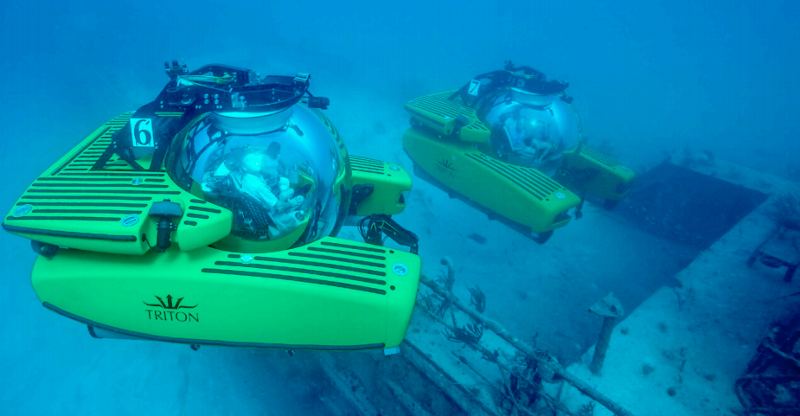If you were to plumb the depth of the oceans, you could only get so far with a snorkel or a SCUBA tank. We don’t know the price, but if you have enough money, you might consider the Triton 3300/6 — a six-person submersible that can go down to 3,300 feet (hence the name–get it–3300/6). Billed as “diving for the entire family,” we aren’t sure we can load grandma and the kids in something like this, but that doesn’t mean we wouldn’t like to try.
The machine can carry up to 1,760 pounds and can make 3 knots which isn’t going to set any speed records. At around 24,000 pounds, the two main thrusters are lucky to make that speed. The view bubble is apparently optically perfect acrylic made by a German company and the company claims the 100-inch diameter bubble is the world’s largest spherical acrylic pressure hull.
The 3,300-foot depth sounds impressive and is much further than you can get with conventional SCUBA gear. However, keep in mind the deepest part of the ocean is nearly 36,000 feet down, and you only have 10 hours of operations, so keep your expectations realistic. Even the ocean’s average depth is about 12,000 feet.
We have to admit the thing looks cool, but we couldn’t find the price since it is probably one of those things that if you have to ask, you can’t afford it. It did make us wonder, though, if anyone has tried their hand at a crewed submersible? There are some technical hurdles. You’d want bulletproof life support and backup systems. Water gets into everything and you probably need an emergency surface capability and maybe want to go down with SCUBA gear the first few attempts. But still. We see things at least this dangerous all the time.
We haven’t seen many attempts, although there was one that had few details (the web site is gone, but the videos remain). There are plenty of ways to track your progress from the topside if you decide to have a go at it.
















Oh, there’s one guy that built his own, the saga is well worth the read, lay I heard the creator was to stand trial for murder.
https://arstechnica.com/gadgets/2017/08/biggest-amateur-built-sub-sinks-owner-is-suspected-of-killing-passenger/
https://arstechnica.com/gaming/2017/08/danish-submarine-mystery-takes-gruesome-bizzare-turns/
https://arstechnica.com/tech-policy/2017/10/danish-amateur-submariner-admits-to-dismembering-reporter/
That is a horrible story
That’s why he recommended to read it, no surprises on your next diving trip.
He also made an attempt at escaping prison since then: https://www.bbc.com/news/world-europe-54612455
There is a relatively large personal submersible community, of private submarine/submersible owners and fans.
A great starting point is psubs.org, suggest joining the mailing list as well as reading the site.
A great starting sub is the K250 (one person) or K350 (two person), these can be built from plans, or purchased used from time to time.
There is a great youtube series by psubs member Hank Pronk (and occasional HaD reader) which follows him building subs:
https://www.youtube.com/c/HankPronk
For the first few decades out community was more focused on getting subs to work, but now we have a few operational and capable subs we now collaborate on scientific missions:
https://www.innerspacescience.org/
https://www.innerspacescience.org/videos
There is also the Community Submersibles Project:
https://www.communitysubmersiblesproject.com/
I’m the current owner of Nekton Gamma (which was owned/restored/modified by Hank Pronk) and looking forward tot the pandemic to be over so we can start diving again.
If you want some insight into how to operate a small sub, I’ve restored Gamma’s (well, really Delta’s, but they are very similar) operating manual:
http://nektongamma.com/docs/delta_operation_manual_remaster_2020-11-15.pdf
Rough pricing:
The large Tritons will likely be in the millions of usd. There was a similar one sold at liquidation for a few 100Ks usd (I think). Building a K250 can be done for under 10K usd, but more like 20K usd. There is a K350 for sale for $30K usd:
http://www.psubs.org/forsale/ragan/
I can try to answer questions and such for folks.
Cheers,
Ian.
“The view bubble is apparently optically perfect acrylic”. It better be!
Three knots means you need a tender ship or you go where there is little to no current. Still, very cool.
“…six-person submersible that can go down to 3,300 feet…”‘
Wear a mask…
If the sea gets in at 3300 feet you’ll end up inside the mask.
https://www.youtube.com/watch?v=X8R4mEvUjBA
Or you can allways build your own sub with an old gas tank
Start smaller ! look at this R/C model sold by Norbert Brueggen. A marvel of engineering. The site is in german and without HTTPS, but still worth a look : http://www.diveteq.de/html/deep_rover_1002.html
“The 3,300-foot depth sounds impressive and is much further than you can get with conventional SCUBA gear. However, keep in mind the deepest part of the ocean is nearly 36,000 feet down,”
But that’s plenty deep enough to explore the Great Lakes.
3300 feet, not far enough to join the mile-deep club.
It’s a Seamoth!